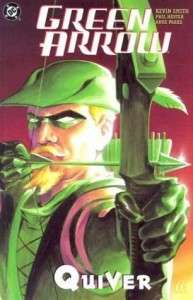
There’s one question I’ve been getting a lot recently, both as a librarian and as a comic book historian – where should I start if I want to read some good Green Arrow
comics? It’s a fair question but it’s also a difficult one for me to
answer fairly. Despite being around for over seventy years, Green Arrow never had a solo comic book
series until the late 1980s and most of those comics have never been
collected in a trade paperback edition. Many of the stories which have
been collected haven’t aged particularly well, with the Dennis O’Neil
penned Green Lantern/Green Arrow comics of the 1970s being particularly cringe-worthy with their groovy dialogue.
For this reason, I usually recommend Green Arrow: Quiver and Green Arrow: The Sounds of Violence. These two trade paperbacks collect all the stories written by the man who brought Green Arrow into the Modern Age of Comics – Kevin Smith. Better known for his work as a filmmaker, Smith was a rather prolific comic book
writer at the turn of the century best known for his inability to meet
deadlines and his outspoken personality. Love him or hate him, one
can’t deny the impact that Smith had on Green Arrow.
What’s it about?
As Quiver opens, we are introduced to
Oliver Queen – the man behind the mask who fought corporate criminals
and corrupt civil servants as The Green Arrow. This introduction comes
through the eyes of his loved ones as they reminisce upon the impact he
had on their lives before his untimely but heroic death. Death? Yes,
as this story opens Oliver Queen is dead. Or is he? There’s a familiar
green-clad figure running around the roof-tops of Star City who begs to
differ and his oldest friends in the Justice League agree this new
Green Arrow sure looks and sounds like Oliver Queen did ten years ago.
But even if Green Arrow has come back from the dead, how did he do it
and for what purpose? And why are his memories and personality those of
a younger Oliver Queen than everyone remembers? The search for answers
will lead the newly resurrected Green Arrow and his allies on a wild
ride through the spiritual side of the DC Comics universe.
The Sounds of Violence continues where Quiver
ends, with a newly resurrected Oliver Queen trying to get on with his
life. His new job overseeing the Star City Youth Center has given him
purpose beyond his nightly patrols and it’s offered him ample time to
bond with Connor Hawke – the illegitimate son he never knew he had. But
Ollie worries that with the world having moved on there may not be a
place for him anymore. At the very least, he worries there’s no place
for him in the life of the lady he most wants to be with – long-time
girlfriend Dinah Lance, a.k.a. The Black Canary. And even as Ollie
seeks to rebuild, a new villain plans to end Ollie’s crime-fighting
career before he can truly restart it.
Notable Notes
Two things stick out above all others in Kevin Smith’s scripts – his love and knowledge of the DC Comics universe and his twisted sense of humor. From the very first scene, we know we’re in for something special as we see Superman and Batman – not as the Big Blue Boy Scout and the dour Dark Knight but as two friends snarking about their first memories of feeling cold (Batman’s involves a sleigh ride and Superman
asks if the sled was named ‘Rosebud’). Despite this story being built
upon some rich history, it is easily accessible to anyone who has never
read a comic book before, much less a Green Arrow comic. Long-time
comic readers may get more out of reading this series, spotting
references to Neil Gaiman’s The Sandman among other things, but one needn’t have a copy of Who’s Who in The DCU on standby to get through it.
The artwork is all-around amazing. Penciler Phil Hester,
who collaborated with Smith previously on a comic based on Smith’s film Clerks,
proves an unorthodox but credible choice to bring Smith’s characters to
life. Hester’s previous works tilted heavily in favor of the horror
genre, which proves fitting given the direction Smith’s story takes
toward the end of Quiver. Inker Ande Parks further adds to the dark and
spooky feeling with some atmospheric inks. Writer/Artist Matt Wagner, who painted the covers for each of the monthly comics and the cover of the TP collections, also deserves high praise.
Significance
This series catapulted Green Arrow into the spotlight and
kept him there for the better part of a decade. The monthly series
began to wane after Smith’s departure but Green Arrow’s newfound
popularity extended into other media, particularly the various animated
adaptations of the Justice League and Batman comics. This eventually led to Ollie becoming a series regular on the Smallville TV show and probably had a hand in inspiring the current Arrow TV series.
Appeal
Fans of Smith’s movies will love these books for their
humor. Fans of superheroes looking for an easily-accessible entryway
into the DCU will also find this series enjoyable. It’s also the first
thing I’d recommend to fans of the new Arrow show, who want to know more
about the comics that inspired the show and how different the two
worlds are.
Why should you own this?
Strictly speaking, these are among the few Green Arrow comics that are easily accessible to a new reader. Sadly, they are out of print and even used copies are going for five-times the original price on-line. Hopefully the success of the Arrow TV show will inspire DC Comics to put these stories back in print, despite their lacking relevance to the New 52 universe.

No comments:
Post a Comment